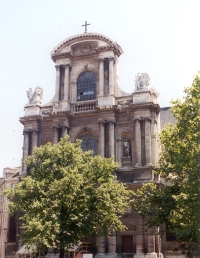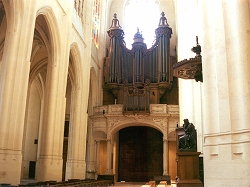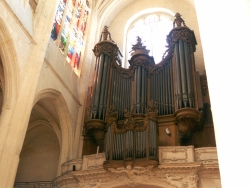Introduction
 As an organ student in the United States, you should be particularly interested in the organ in the Church of St. Gervais in Paris. That assumption is based on the fact that most American organists find their introduction to French Classical music in the works of François "le Grand" Couperin (1668-1733). The church of St. Gervais was home to organists in the Couperin family for almost 200 years, from the early 1600's until the 1820's, so if you want to learn something of the circumstances surrounding the creation of their music, you have to know something about the church and its organ. As an organ student in the United States, you should be particularly interested in the organ in the Church of St. Gervais in Paris. That assumption is based on the fact that most American organists find their introduction to French Classical music in the works of François "le Grand" Couperin (1668-1733). The church of St. Gervais was home to organists in the Couperin family for almost 200 years, from the early 1600's until the 1820's, so if you want to learn something of the circumstances surrounding the creation of their music, you have to know something about the church and its organ.
The building itself presents a unique façade, and if you travel around Paris very much, you'll find the church easy to recognize just because it doesn't look like the others. In fact, even though the church dates from the fifteenth century, and the interior of the church is in the Gothic style, the façade -- the last part of the building to be completed -- was the first classical façade built in Paris. With its muldtiple levels based on a different number of well-proportioned rectangles, and its classical columns breaking up the large expanse of stone, it has a balance and grace you don't often see in a Gothic church. When you go to the church, take a few minutes to study its appearance before you go inside.
The organ in St. Gervais was built by Pierre Thierry from 1649-1650. It has been altered several times since the eighteenth century, and although there has been in part a return to the disposition of the seventeenth century, the organ is not the same one that Couperin played. We do know, however, the disposition of the instrument as it was in his day, the building has the same acoustical properties, and the case still gives us a look at the organ as it was built.
 The case is typical of the French classical organ: The case is typical of the French classical organ:
- The main case has two tall towers and a smaller tower in the center.
- The three towers are separated by single-story flats.
- All pipes of the main façade stand at the impost level.
- The base is narrower than the upper section of the case.
- The Positif case reflects the proportions of the main case in a smaller size.

|


 As an organ student in the United States, you should be particularly interested in the organ in the Church of St. Gervais in Paris. That assumption is based on the fact that most American organists find their introduction to French Classical music in the works of François "le Grand" Couperin (1668-1733). The church of St. Gervais was home to organists in the Couperin family for almost 200 years, from the early 1600's until the 1820's, so if you want to learn something of the circumstances surrounding the creation of their music, you have to know something about the church and its organ.
As an organ student in the United States, you should be particularly interested in the organ in the Church of St. Gervais in Paris. That assumption is based on the fact that most American organists find their introduction to French Classical music in the works of François "le Grand" Couperin (1668-1733). The church of St. Gervais was home to organists in the Couperin family for almost 200 years, from the early 1600's until the 1820's, so if you want to learn something of the circumstances surrounding the creation of their music, you have to know something about the church and its organ. The case is typical of the French classical organ:
The case is typical of the French classical organ: